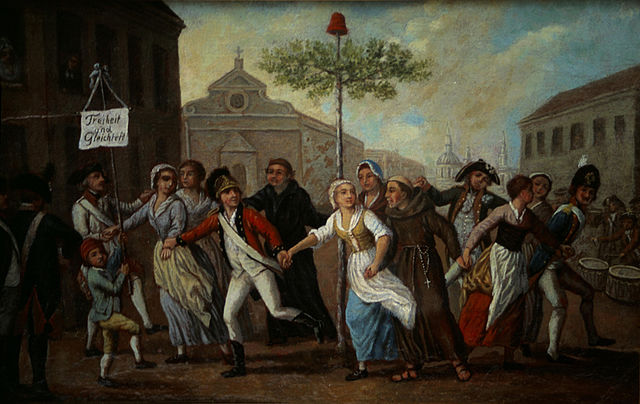A liberty pole is a wooden pole, or sometimes spear or lance, surmounted by a "cap of liberty", mostly of the Phrygian cap. The symbol originated in the immediate aftermath of the assassination of the Roman dictator Julius Caesar by a group of Rome's Senators in 44 BCE. Immediately after Caesar was killed the assassins, or Liberatores as they called themselves, went through the streets with their bloody weapons held up, one carrying a pileus carried on the tip of a spear. This symbolized that the Roman people had been freed from the rule of Caesar, which the assassins claimed had become a tyranny because it overstepped the authority of the Senate and thus betrayed the Republic.
Germans dancing round a Tree of Liberty/Liberty Pole, 1792–1795.
Gérard de Lairesse, the Dutch Maiden in his Allegory of the Freedom of Trade (glorify the De Graeff family’ as the protector of the Republican state), 1672
Dutch allegory for the Netherlands/US trade treaty, 1782. Personification of the Americas, left, "Indian princess" and classical hybrid for the US centre, Dutch Maiden right.
French painting of the Triumph of Liberty, c. 1790. The cap is a contemporary man's hat. The Gallic cock accompanies Liberty.
The Phrygian cap or liberty cap is a soft conical cap with the apex bent over, associated in antiquity with several peoples in Eastern Europe and Anatolia, including the Persians, the Medes and the Scythians, as well as in the Balkans, Dacia, Thrace and in Phrygia, where the name originated. The oldest depiction of the Phrygian cap is from Persepolis in Iran.
Dacian prisoner with Phrygian cap (Roman statue from the 2nd century)
A Parthian (right) wearing a Phrygian cap; detail from the Arch of Septimius Severus, Rome (203 AD).
Orpheus with Phrygian cap.
Dacian sculpture with Phrygian Cap.








